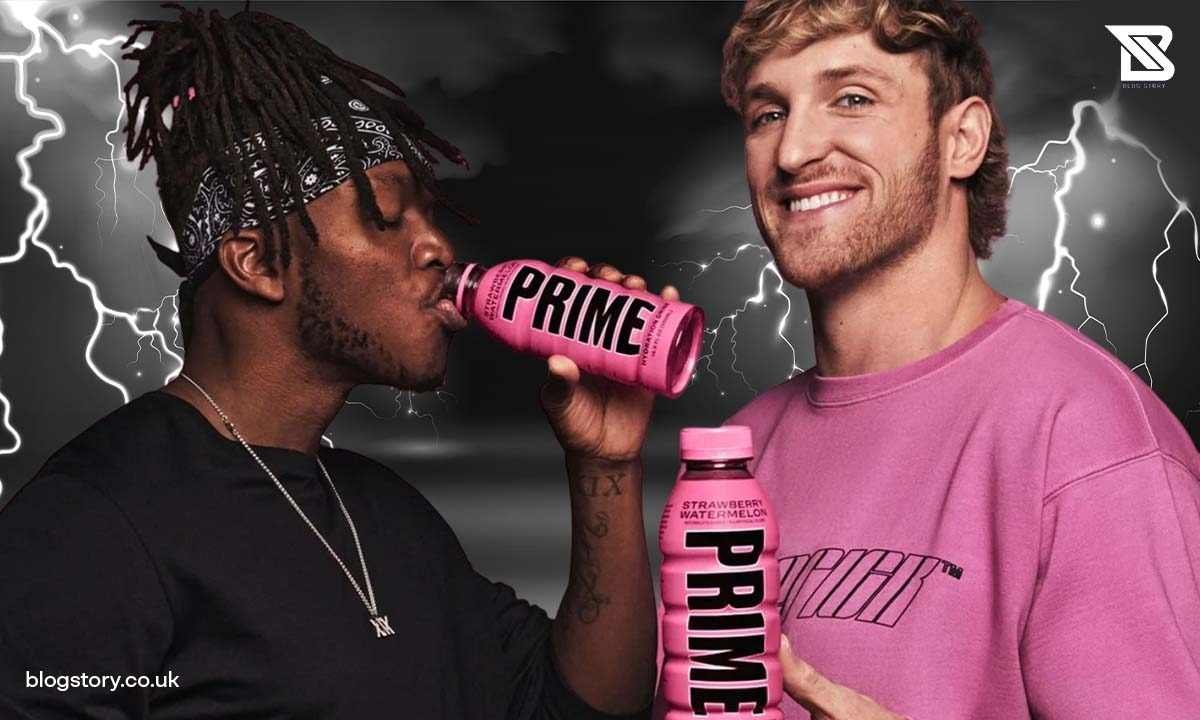
Prime Energy Drink: Know The Truth Behind This Viral Drink
Hey, social media enthusiasts! Ever heard of Prime Energy Drink, the trendy new sports drink that’s been blowing up on TikTok with a whopping 61 million views?
Yep, that’s Drinkprime for you!
This cool beverage is not just a hit with influencers but has also become the official sports drink of the UFC (Ultimate Fighting Championship).
Guess what?
Senator Charles Schumer got curious about Prime Energy Drink too!
Back in July 2023, he asked the FDA to dig into Prime’s marketing strategies and the caffeine buzz it brings.
So, let’s spill the tea on the Prime controversy and find out what’s really going on inside those flashy neon cans!
What is Prime Energy Drink?

Cooked up in 2022 by YouTube stars and boxing buddies Logan Paul and KSI (Olajide Olayinka Williams Olatunji), Prime drinks are all about delivering “bold, thirst-quenching flavors to help you refresh, replenish, and refuel,” as per their snazzy website.
Meet Prime Hydration, the caffeine-free gem in Prime’s lineup. You can grab it in 16-fluid-ounce bottles or handy hydration packets for on-the-go mixing. With 10 flavors like Glowberry and Ice Pop, there’s a taste for everyone.
Now, let’s talk about Prime Energy – a punchy addition to the family.
Packed in 12-ounce cans, it’s the go-to for an energy boost, packing a caffeinated punch with 200 milligrams per serving.
Tropical Punch and Blue Raspberry are just a couple of the seven flavors that’ll kick your taste buds into high gear!
Energy Drink Prime Vs. Hydration Drink Prime
Diving into the Prime world, let’s explore the distinction between Prime Hydration and Prime Energy Drink.
According to Avery Zenker, a registered dietitian at EverFlex Fitness in Canada, Prime Hydration takes on the vibe of a sports drink, boasting a blend of electrolytes and vitamins. It’s the ultimate refresher for those active moments.
On the other hand, Prime Energy Drink steps into the ring as more of an energy drink, thanks to its robust caffeine content—considered a real stimulant, as highlighted by Zenker.
Now, here’s the caffeine kicker: Prime Energy Drink comes with a label waving a caution flag, advising against consumption for those under 18, individuals sensitive to caffeine, and pregnant or nursing women.
This move aligns with the guidelines set by the American Beverage Association (ABA) for caffeinated beverages. So, Prime Hydration for the sporty vibes, and Prime Energy Drink when you need that extra jolt—with a side note for caution!
Ingredients: Prime Energy Drinks
Let’s unravel the composition of Prime Energy Drink, dissecting the intricacies of its ingredients with insights from our expert panel. The beverage, curated to provide a potent energy boost, unfolds its recipe for rejuvenation through a careful selection of components.
At the heart of Prime Energy Drink is carbonated filtered water, a crisp and effervescent base that lays the foundation for the energetic concoction.
The infusion of coconut water from the concentrate introduces a tropical twist, contributing not only to the flavor profile but also infusing the drink with the natural goodness of coconut.
Vitamins take the stage in the form of vitamin B6 and vitamin B12, essential players known for their role in supporting energy metabolism. These vitamins add a nutritional dimension to the beverage, enhancing its overall appeal.
Electrolytes, including sodium, magnesium, and potassium, step in to replenish essential minerals, ensuring a harmonious balance that aligns with Prime Energy Drink’s energy-boosting mission.
Natural flavors further elevate the taste experience, creating a sensory journey with every sip.
The Sweet Side
As with any energy elixir, the sweet note is introduced by sucralose, an artificial sweetener that imparts sweetness without the added calories.
To preserve the freshness and integrity of Prime Energy Drink, preservatives in the form of potassium sorbate and sodium benzoate are incorporated, ensuring a prolonged shelf life.
Amino acids, specifically L-theanine and taurine, make their presence felt in Prime Energy Drink. These powerhouse compounds contribute to the beverage’s potential to enhance cognitive function and overall alertness, aligning with the energy-boosting narrative.
Inositol, a sugar alcohol, adds another layer to the mix, offering a subtle sweetness while contributing to the overall flavor complexity. Caffeine, a well-known stimulant, takes centre stage, providing the kick that defines Prime Energy Drink as an invigorating beverage.
An interesting inclusion in the lineup is glucuronolactone, A compound that is naturally present in the body and frequently included in the formulation of energy beverages.
This compound, known for its potential to support mental alertness, adds a distinctive touch to Prime Energy’s formula.
As we dissect the ingredients, it becomes evident that Prime Energy Drink is a carefully crafted fusion of natural elements and scientifically backed components.
The synergy of these ingredients aims to deliver not just a burst of energy but a holistic and flavorful experience for those seeking a revitalizing beverage.
Ingredients: Prime Hydration Drinks
Let’s take a deep dive into the makeup of Prime Hydration by examining the detailed insights provided by registered dietitians Avery Zenker and Christina Lombardi.
These nutrition experts shed light on the comprehensive list of ingredients that constitute Prime Hydration drinks, unraveling the beverage’s composition and nutritional nuances.
At its core, Prime Hydration boasts a refreshing blend of elements, starting with its hydrating base of:
- Water,
- coconut water.
Other ingredients also play a pivotal role in replenishing essential minerals lost during intense physical activity. Those are:
- Electrolytes,
- Including sodium,
- Magnesium,
- Potassium.
The inclusion of branched-chain amino acids (BCAAs) adds another layer to the mix, emphasizing the significance of these essential amino acids in the realm of protein synthesis and muscle building.
Prime Hydration doesn’t stop there—it goes on to incorporate antioxidant vitamins A and E, alongside a dose of B vitamins.
While the B vitamins contribute to overall nutritional value, it’s noteworthy that they don’t directly enhance the hydration potential of the beverage, according to insights from Leslie Bonci, sports dietitian for the Kansas City Chiefs.
The Sweet Side
Now, let’s address the sweet side of Prime Hydration.
Artificial sweeteners, namely sucralose and acesulfame potassium, step in to provide a sweet taste without the added calories.
However, as Zenker points out, the impact of these artificial sweeteners, particularly in children, remains an area of ongoing research.
Their sweeter-than-sugar taste may influence taste preferences, sparking an intriguing conversation about their long-term effects and the need for continued exploration in this domain.
Delving into the specifics, Prime Hydration employs natural flavours, gum arabic, and ester gum as stabilizers, ensuring a well-rounded and stable composition. Sea salt makes an appearance in the hydration sticks, contributing to the electrolyte mix.
One intriguing facet brought to light by dietitian Lindsay Malone is the sodium content in Prime Hydration. With only 10 milligrams per serving, it falls below the sodium levels found in other sports drinks, potentially impacting fluid balance after strenuous exercise.
Leslie Bonci adds an additional layer of insight by addressing the carbohydrate content in Prime Hydration. At 5 grams, it falls below the optimal range of 40 to 80 grams per 500 milliliters (one serving) for a sports drink, highlighting a potential area for improvement.
The inclusion of BCAAs, essential amino acids, raises questions about their impact during exercise. While they may aid in performance and muscle building, the absence of detailed labelling regarding BCAA content leaves room for speculation about their effectiveness.
Wrapping up the nutritional analysis, Zenker emphasises the presence of artificial sweeteners and the need for continued research to uncover their long-term effects.
As she rightly points out, the intricate balance of ingredients in Prime Hydration paints a complex picture, and further exploration is warranted to fully understand its nutritional impact.
Prime Energy Drink: The Caffeine Content
Let’s delve into the caffeine realm of Prime Energy, where each 12-ounce serving can pack a punch with 200 milligrams of caffeine.
Caffeine Kick: Each 12-ounce serving of Prime Energy brings a robust caffeine dose of 200 milligrams.
FDA Guidelines: The FDA indicates that a daily caffeine intake of up to 400 milligrams in healthy adults is generally considered safe, steering clear of adverse effects like insomnia, jitters, and a racing heart rate.
Comparison with Coffee: To put it in perspective, an 8-ounce cup of coffee typically contains about 95 milligrams of caffeine.
High Caffeine Concentration: Prime Energy stands out with a notably higher caffeine concentration compared to popular energy drinks. Red Bull, for instance, contains 80 milligrams in an 8.4-ounce can, while Rockstar amps it up to 160 milligrams in a 16-ounce can.
Stimulant vs. Energy: Leslie Bonci stresses the distinction between caffeine as a stimulant and energy derived from calories. While caffeine can boost focus and reaction time, elevate heart rate, and increase respiration rate, it doesn’t provide caloric energy. Prime Energy, with a modest 10 calories per serving, falls into the low-calorie stimulant category.
Misleading Terminology: Bonci points out the potential deception in labeling such products as “energy drinks” when they primarily function as low-calorie stimulant drinks. Understanding this nuance helps clarify the true nature of Prime Energy’s contribution to your daily energy boost.
Is Prime Energy Drink Safe to Consume?
As we delve into the safety concerns surrounding Prime Energy, a closer examination reveals various perspectives and calls for an investigation.
Sen. Schumer’s Call for Scrutiny
In July 2023, Senator Schumer raised an alarm regarding Prime Energy’s online marketing practices, particularly emphasizing the potential lack of clear distinctions between the ‘hydration’ and ‘energy’ forms of the Prime beverage.
Expressing concern about the brand’s widespread availability and its appeal to individuals under 18, Schumer urged the FDA to investigate Prime for its claims, marketing strategies, and caffeine content.
Targeting The Youth Market
A pivotal point of contention is Prime Energy’s marketing approach, which, according to Schumer, captivates children and adolescents.
This is a red flag, especially considering that Prime Energy Drink, while labelled for those 18 and older, heavily targets a demographic that may not discern the differences between Prime Energy and Prime Hydration.
Caffeine Concerns Raised by Experts
Lindsay Malone, a registered dietitian, underscores a primary worry associated with Prime Energy Drink—its caffeine content.
Despite the age-related labelling, Malone observes that Prime Energy’s marketing predominantly targets young individuals who might not fully grasp the disparity between the energy and hydration variants.
The Larger Landscape of Energy Drink Marketing
Harvard Health notes a broader trend in the marketing strategies of energy drinks.
It highlights their popularity among teenagers and young adults, making them the second most widely consumed dietary supplement in this demographic after multivitamins, as per the National Institutes of Health.
Caffeine and Children: A Delicate Balance
The American Academy of Pediatrics discourages the intake of caffeine for children below the age of 12 and recommends that those aged 12 to 18 years not exceed 100 milligrams of caffeine per day.
These guidelines shed light on the potential risks associated with caffeine intake in younger age groups.
Regulatory Gaps and Concerns
While the FDA does not currently regulate energy drinks, there is a caffeine limit of 71 milligrams per 12-ounce serving for sodas, as highlighted by Harvard Health.
However, the classification of energy drinks as supplements allows many manufacturers to circumvent this threshold.
Potential Health Impacts Highlighted by CDC
The Centers for Disease Control and Prevention (CDC) raises awareness about potential negative effects linked to energy drinks. These encompass impacts on the heart, dehydration, anxiety, and sleep disturbances such as insomnia.
Complications range from irregular heartbeat and heart failure to feelings of nervousness and jitteriness, along with the risks of dehydration and its associated consequences.
Cautionary Note for Consumers
A final word of caution comes from Avery Zenker, who emphasises that while Prime Energy Drink may be deemed safe for some adults, consuming two servings could potentially exceed the FDA’s recommended daily safe limit of 400 milligrams for caffeine.
This insight prompts a careful consideration of individual caffeine tolerance and overall health implications.
Is Prime Drinks Suitable For You?
To gauge whether Prime drinks align with your lifestyle and health, consider the following factors.
Health Conditions Consideration
- Assess your health conditions, especially if you are pregnant or nursing.
- Take into account your overall diet, existing supplements, and any potential interactions.
Holistic Wellness Evaluation
- Factor in aspects like physical activity and sleep quality for a comprehensive evaluation.
- Identify if you are using these drinks as substitutes for essential components like regular meals, proper hydration, or sufficient sleep.
Explore Alternative Solutions
- Lombardi suggests exploring alternative solutions for underlying issues, such as opting for nutrient-rich foods and prioritising adequate sleep over reliance on these drinks.
Ingredients Scrutiny
- If you determine a need for sports or energy drinks, delve into the ingredients list.
- Pay special attention to the electrolyte content, as emphasised by Malone. Different brands offer varying profiles, some with more robust electrolytes and without artificial sweeteners.
Comparison with Other Brands
- Acknowledge that Prime drinks contain fewer electrolytes and calories compared to some other brands.
- White and Bonci caution against relying on Prime for optimal hydration and electrolytes, especially during physical activity or for energy needs.
Caution for College Athletes
- College athletes should exercise caution when selecting energy drinks.
- Lombardi highlights the importance of checking for substances like taurine and caffeine, which may be prohibited. Choosing NSF-certified products and seeking guidance on banned substances is advisable.
By considering these aspects, you can make an informed decision about whether Prime drinks align with your health goals and overall well-being.
Is Prime an Energy Drink?
It’s not just any energy drink – it’s the brainchild of Logan Paul and KSI, hitting the scene in 2022. Perfect for the 18 and up crew, Prime packs a punch with 200 mg of caffeine, zero added sugar, and flavours like tropical punch and strawberry watermelon.
But here’s the scoop: if you’re under 18, sensitive to caffeine, or expecting or nursing, Prime might not be your go-to. Stay fueled responsibly!
Is Prime Hydration an Energy Drink?
Prime Hydration isn’t just your average energy drink – it’s a sports drink, as per the Prime website.
Zero sugar, and no caffeine, and it’s sweetened with aspartame. Packed with electrolytes and BCAAs, it’s your secret weapon for post-workout recovery.
Oh, and did I mention it’s the official sports drink of the UFC?
With eight awesome flavours, you’re in for a hydrating treat!
Final Talks
Prime energy drink and Prime hydration drinks, both are different. Here, in this article, I have talked about both of them and as per that, you can decide on what drink you should opt for.
And when you are taking any of these, always ensure you are considering the safety measures. In case you have any further queries and questions, feel free to leave them in the comment section and I’ll come up with a solution as soon as possible.
You May Like Also:













This was an amazing read! Your insights on this topic are very valuable and have given me a lot to think about. I appreciate the time and effort you put into researching and writing this post. Thank you for sharing your knowledge with us.
Dead pent subject material, Really enjoyed looking at.
There may be noticeably a bundle to learn about this. I assume you made certain nice factors in features also.
Howdy! Do you use Twitter? I’d like to follow you if that would be okay. I’m absolutely enjoying your blog and look forward to new posts.